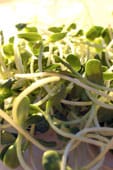I once watched a grandmotherly woman dipping her fingers in a big tub of donut icing and spreading them on fresh-baked cinnamon rolls, as she explained to me that her procedure was much quicker than the spatula-method I was using. That may have been so, but we were working in a retail donut shop where bare-hand contact with ready-to-eat products wouldn’t fly with the health inspectors. 
You have the right to treat your own food in any manner you please. But when feeding others, you’re obligated to do all you can to make it safe.
A mom of three in Teaneck, New Jersey, wanted to bake and sell "mortgage apple cakes" to forestall the foreclosure on her home. When more than 500 orders for the $40 cakes came in, Angela Logan was ready to get baking.
But, according to the Associated Press, Teaneck’s health officer notified Logan that it was against state law to use her house as a commercial kitchen.
She would have to bake in a kitchen subject to food safety inspections.
The AP reports that, since the notification, "the Hilton Hasbrouck Heights has allowed Logan to cook in the hotel’s kitchen, where she can produce up to 10 cakes at a time."
That’s very generous of the hotel. I wonder if they gave Logan any food safety training, or just the use of inspected facilities? Both are important if Logan’s customers are going to have their cakes and eat them, too.


 "Though it is unlikely to get sick from visiting one of these places, health experts say germs are always a gamble. The more people who touch and visit a spot, the more germs there are in the mix, they say.
"Though it is unlikely to get sick from visiting one of these places, health experts say germs are always a gamble. The more people who touch and visit a spot, the more germs there are in the mix, they say.



 with other glasses throughout the restaurant. She joked that it’s like making out with everyone there.
with other glasses throughout the restaurant. She joked that it’s like making out with everyone there. .jpg)